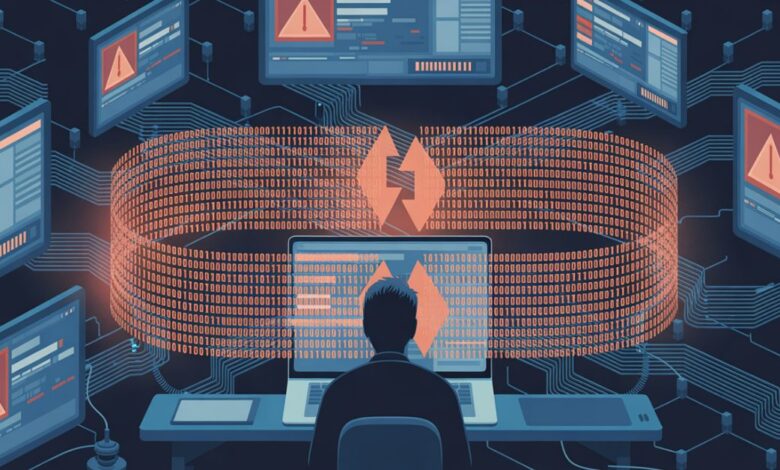Replay Attacks: The Silent Threat Undermining Digital Security

Replay attacks are a type of cyber-attack that is the least discussed but most hazardous ones since they can aim at authentication procedures, channel of communication, and safe transactions. The possibilities of attackers are increasing as the number of digital systems grows, and more important interactions begin to occur online. The mechanism of replay attack and how it can be avoided by organizations is the key to organization guaranteeing high level of security in the modern interconnected world.
What Are Replay Attacks?
A replay attack is an attack in which a malicious user intercepts legitimate information between two actors, and subsequently reuses the information or replays it to obtain an unauthorized access. The attacker does not decrypt the encryption key or crack a password but takes advantage of the faith in the credentials or messages that were used in the past. The attacker deceives the system by re-sending valid authentication information that an actual and authorized user is connected to the system. In most instances, replay attacks do not necessitate very advanced technical skills and so they are a favorite means of attacker to bypass electronic security without necessarily attacking the encryption algorithms themselves. They frequently include session tokens, network traffic snatching, or authentication messages and thereafter employing this data in the future.
How Replay Attacks Work
Interception is involved in the process behind a replay attack. The attackers employ packet sniffing, session hijacking, or man-in-the-middle positioning to intercept the information that is being exchanged between a user and a server. Such hijacked data may contain login credentials, encrypted authentication tokens, biometric data packets, or authorization messages. After capturing the data, the attacker tries to reenact the specific communication. To use a case in point, a client pours into an online banking system, and the hacker intercepts the authentication token, the hacker can re-read the token and gain access to the bank account of the user. The system can verify the attacker unless something extra is implemented to verify the token unless it had been invalidated between the moment of transmission and the integrity of the message. Replay attacks are successful in those systems where the authentication messages are not lost immediately and where there is no system that can be used to check the freshness of the transaction. The unprotected information can be repeated later without intercepting the information without protection mechanisms like nonces, timestamps, or sample-session data.
The Reasons Replay Attacks are Menacing.
Attacks that are in the form of replay can be devastating to the individuals, organizations, and even entire digital networks. They are aimed at the heart of trust-based communication. Attackers may access sensitive data, commit fraud, or use transactions when a system does not differentiate between a legitimate request and a replayed message.
In the case of business, it can be a big financial blow. Attackers have the ability to impersonate customers, employees or automated systems, resulting in unauthorized transactions, data breach and reputational damage. Replay attacks can affect the services in industries like finance, healthcare and e-commerce by breaking the rules and regulations.
Moreover, the replay attacks are not easily spotted. Logs might not be showing suspicious behavior immediately as the attacker uses valid credentials or messages. Most organizations end up discovering the attack when it is already too late.
Frequent Targets of Replay Attacks.
The main targets are systems that do not have good authentication systems. Outdated communication protocols, legacy systems, and API are especially easy to exploit. The contemporary digital ecosystems, specifically, biometric-enabled authentication systems like facial recognition or fingerprint scanning, are also susceptible to replay attacks. Attackers can circumvent liveness detection and become a legitimate user in case biometric data packets are intercepted and replayed.
Banking websites, web 1.0 system single-sign-on solutions, smart homes, IoT networks and e-commerce portals are common targets of replay attacks, owing to the sensitive nature of the information they handle and the importance of unauthorized access.
Preventing Replay Attacks in Organisations.
To avoid replay attack, it is necessary that there should be the multi-layered approach that is aimed at assuring the uniqueness and authenticity of each interaction. Timestamps are one of the best protection mechanisms. Systems can dismiss any request that seems to be old, by scribbling the time of the message and maintaining strict windows of validity.
Nonces, or random numbers that are created per transaction are also important. Replayed data cannot be used when the server will demand that a nonce will follow a particular session or request. When attackers re-deliver a message that is old, it will not have the same nonce, and the attempt will be blocked by the system.
Encryption is a necessity too but it is most effective with other protection mechanisms. Even the encrypted packets may be repackaged when the system fails to authenticate the freshness of the message. The additional resistance against the malicious attempts to reuse data is provided by the mutual authentication protocols, authentication based on the session, and a secure key exchange mechanism. Liveness detection in biometric systems is an effective way of minimizing replay. Liveness is a process that identifies that the user is alive at the time of verification so that attackers cannot use biometric data taken or the counterfeit media to pass the test.
Lastly, network monitoring and anomaly detection tools could be used to detect unusual behavior which can indicate an ongoing replay attack. The need to examine the pattern of logins, anomalies in IP addresses, or frequent authentication is an added security layer provided by systems.
Conclusion
Replay attacks emphasize the significance of authentication not only of the identity of a user, but also of his or her actions, when and how they occur. With the further development of digital systems, the attackers will be following their attempts to find the vulnerabilities in communication and authentication. To be ahead of the game, organizations should introduce powerful anti-replay systems, track suspected activity, and protect all interactions with time-sensitive and session-aware security. Being aware of the replay attacks concept and implementing preventive measures will help businesses and personalities to enhance their digital security and forestall unauthorized entry into the world which is increasingly becoming interconnected.




